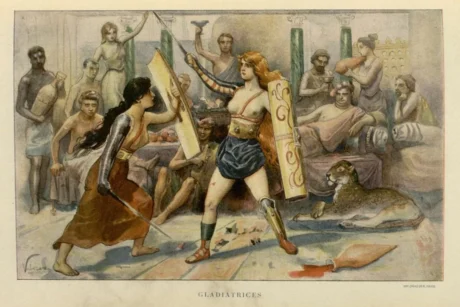In honor of Women’s History Month, we are having fun researching some seriously powerful and wild women of our world’s past. The following will share some interesting information about female gladiators, gladiatrices or Amazons as they were called; and yes, they have been proven to have existed.
For many years, the existence of female gladiators was only mentioned in historical accounts with no real physical proof to back up the records. Scholars had no physical evidence to support the ancient records claiming the existence of female gladiators until a curious grave was discovered.
Archaeologists made a striking discovery around the end of the last century near the Roman Amphitheatre in London, England. To this day, scholars believe that the grave belonged to a woman in her mid-20s who was a well-respected gladiatrix. Although only a small part of her body remained, the items laid in the grave were evident enough to suggest this storyline. Along with the expensive trinkets, there were signs of a funeral feast that would suggest the burial of a respected woman.
It is now considered a fact that gladiatrices existed and played their part in the famous gladiator games in Ancient Rome.
Archaeologists also discovered a curious Roman plaque in Bodrum, Turkey that depicted two warriors, believed to be female gladiators. The plaque also carried the names of the two figures – Amazon and Achillia. Was it not for the inscriptions, scholars would have probably considered the figures to be male.
Also found was a statue of a female gladiator of unknown origin but in the style of the Italian peninsula, currently housed at the Museum fur Kunst und Gewerbein in Hamburg, Germany.
The Roman Empire spanned across several continents over a 1,500-year imperial history, and its influences expanded far beyond the city of Rome. Its famous Colosseum still stands in Italy today, but there were so many more stadiums built to house their famous gladiator battles.
When most people think of the Roman Gladiators, they think of the men who were captured as prisoners of war and forced into battles to the death for the sake of entertainment.
In many cases, this was true, and men became motivated to train as hard as they could, because there was a chance to win prize money that could make a man rich enough to buy his freedom and return to his family.
However, many high-class men in society chose to become career Gladiators of their own free will, despite the fact that it meant a much shorter lifespan.
Warrior Women
Knowing that women had limited rights in Ancient Rome, especially when it came to warfare and combat, it may surprise you that female gladiators truly existed. According to the ancient historians, gladiatrices (as we refer to them today) were a rare occurrence but there were those that actively participated in gladiator games.
Although most sources that describe female gladiators are uncertain, we do know a thing or two about these fierce women. These women were also sometimes called “The Amazons”, since they were meant to evoke the legends of the powerful women.
These beautiful, powerful Amazonians quickly grew a fan base among Romans.
People came to see the same performers again and again as they grew stronger and better at fighting in the Colosseum. Dolls, oil lamps, and pieces of art were made in the likeness of both male and female gladiators that spectators could purchase and take home as souvenirs.
More and more women eventually wanted to join the competition as a Gladiatrix.
Rather than token performances, they began to actually fight one another in tournaments where they were eligible to win prize money. They were never allowed to go up against the men, but female fighters were paired off in fights against one another. Just like modern-day wrestling, each woman was given a character with a story arch, along with weapons and costumes.
Gladiatrices were not allowed female costumes.
They fought in the same way men did – shirtless. As you can guess, this was one of the reasons why the crowd loved female gladiator battles.
Some scholars suggest that the nudity was there merely because it was more convenient for women to fight this way while others believe that it was purposely done to add up an erotic sense to the otherwise bloody scenery.
Marriage was Forbidden to Female Gladiators
It seems like most we know about female gladiators is the way society reacted to their existence. Here is another disadvantage that they had to bear with – once they chose the life of a gladiatrix, they had to forget about marriages.
Successful male gladiators who survived the arena were extremely respected to an extent that the crowd considered them heroes.
Female gladiators, on the other hand, were considered equal to prostitutes even if they survived many battles. It is understandable to some extent having that their fighting costumes did not cover most of their bodies.
Once again gender inequality showcased as we come back to how disrespected gladiatrices were in ancient Rome. Yes, people enjoyed their performances and were awed by their power and athleticism; but still, they were considered “untouchable”.
The balance of equality lays in findings that show successful female gladiators were ‘respected’; if not considered ‘respectable’ through items being found inside the graves of ancient female warriors.
(Paragraph 3 above)
Celebrating Warrior Women (Gladiatrices) in History
March 27, 2022 by






